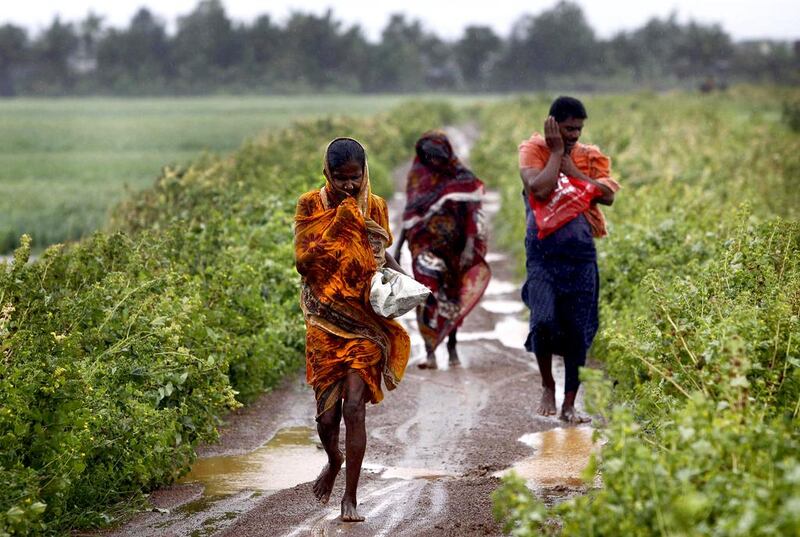NEW DELHI // At least seven people died and more than 600,000 fled their homes in panic yesterday as the Indian Ocean’s fiercest recorded storm slammed into eastern India.
Cyclone Phailin made landfall near the town of Srikakulam in Andhra Pradesh with driving rain and wind speeds of nearly 200kph.
A few hours before the storm hit, about 200 villagers were jammed into a two-room schoolhouse in the village of Subalaya in Odisha, about 30 kilometres from the coast, where emergency officials were distributing food and water.
The roads were almost completely empty of traffic, but two lorries pulled up to the school with more evacuees. Children shivered in the rain as they stepped down from the vehicles, following women carrying bags jammed with possessions.
Many had fled low-lying villages for the shelter of the concrete school. Some left behind relatives who feared the storm could wipe out lifetimes of work.
“My son had to stay back with his wife because of the cattle and belongings,” said Kaushalya Jena, 70, weeping in fear inside the makeshift shelter. “I don’t know if they are safe.”
In Berhampur, a town in Odisha about 10 kilometres inland, the sky darkened quickly as the storm hit, with strong winds and rain pelting the empty streets.
“My parents have been calling me regularly … they are worried,” said Hemant Pati, 27, who was holed up in a Berhampur hotel with 15 other people from Srikakulam.
The hotel manager said he would bar the doors against anyone trying to enter, and there would be food, water and electricity from generators only for guests of the Hotel Jyoti Residency. “Nobody can come inside, and nobody can go out,” Shaik Nisaruddin said.
The coastal states of Odisha and Andhra Pradesh bore the brunt of the cyclone’s force. Off the Odisha coast, the sea surged by nearly three metres, swamping small villages and farms.
“The skies have been completely dark for some time now, and the rain is continuous,” Soumitra Pattnaik, a resident of Odisha’s capital Bhubaneshwar, said an hour before landfall.
“The power has been cut since 9am, and it will be this way until the morning,” Mr Pattnaik said. “We’ve been told not to go outside for 24 to 48 hours.”
Phailin has been compared in strength to Hurricane Katrina, which damaged property worth US$81 billion (Dh297.27bn) in the United States in 2005. It also revived memories of a cyclone that hit Odisha in 1999, killing nearly 10,000 and causing $4.5bn in damage.
Jatin Singh, the chief executive of SkyMet, a private weather forecaster, said the coast was now far better prepared but the economic cost would be dire.
“I don’t think you’ll see 10,000 people dying here,” he said. “They’ve evacuated people living in mud and thatch huts, there has been more forewarning, and there are more cyclone shelters.”
It will take three to four weeks to assess Phailin’s economic effect, Mr Singh said, and fishing and agriculture would be hardest hit.
“There’s a [rice] paddy crop that is just ready for harvest,” he said, “but it is going to be wiped out because Odisha will get something like 250 millimetres of rain in half a day.”
The major port of Paradip ceased cargo operations on Friday and moved all its vessels – including an oil tanker – to safer harbours.
The 1999 cyclone wrecked Odisha’s economy. As much as 17.5 billion-rupees (Dh1.05bn) worth of crops were destroyed, 500,000 cattle were killed and thousands of fishing boats were destroyed. The state government had to finance the reconstruction of nearly 1.2 million homes, spending an estimated 70bn rupees on food, health and shelter. The Paradip port alone suffered 800m rupees’ worth of damage.
Odisha and Andhra Pradesh will continue to experience heavy rain for several days.
The precise location of Phailin’s landfall may have tempered its effect, the meteorologist Jeff Masters wrote on his Weather Underground blog yesterday.
“The region of the coast where Phailin hit is not as low-lying, though, which should keep the death toll due to storm surge much lower compared to the 1999 Odisha Cyclone, where more than 70 per cent of the deaths occurred due to the storm surge,” Mr Masters wrote.
But “Phailin’s heavy rains will be capable of causing very destructive flooding”.
Across the eastern coast, 2,000 National Disaster Response Force personnel fanned out to expedite evacuations and rescues.
The evacuees in Odisha and Andhra Pradesh have been housed in 500 purpose-built cyclone camps, with each shelter able to accommodate 1,500 people.
The National Disaster Management Authority has set up emergency contact centres in Odisha and Andhra Pradesh.
ssubramanian@thenational.ae
* Additional reporting by the Associated Press





